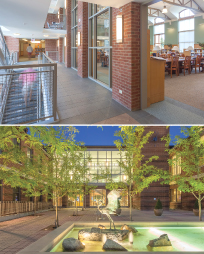
Architects build for practical purposes. Ideally, they build in a specific setting for the people in that setting. Successful design comes from understanding the objectives of the building’s owners, and collaborating with them to create a facility that reflects its objectives. The best libraries are designed using such an approach. It’s a process that requires listening to every voice with a stake in the outcome and establishing a clear set of goals and paths to meet them.
The first step is to form a building committee that represents various constituencies: political representatives of the wider community, the library board of trustees, the professional staff, frequent library users, interested citizens, and donors. All have vital ideas and opinions.
The design process involves analyzing the physical and cultural setting for the building, preparing a program of space requirements, establishing clear objectives for the project, and preparing and critiquing a series of alternative design approaches. Other considerations enter into the process: regulations, the budget, the schedule. Often, additional presentations are made to separate constituencies, including the town board, the planning board, and the architectural review board. The process is repetitive—alternatives are repeatedly developed and evaluated until consensus is achieved—but necessary to ensure that all parties’ issues and concerns are addressed.
The collaboration is time consuming and rigorous. It moves forward, but its iterative nature may slow it down. This is to be expected and is ultimately worthwhile. As the project evolves, the architect, the building committee, and outside constituencies gradually move to a plan that satisfies everyone.
This process works. When successful, the library belongs in its physical and cultural settings, reflects the objectives and values of the various constituencies linked to the project, and is integral to the community and the citizens for which it was designed.
Building Darien Library
Designing Darien (Conn.) Library was an intensely collaborative process. In addition to an active building committee, the library board of trustees, library administration and staff, Friends of the Library, donors, town selectmen, planning board, and architectural review board were all involved. After many discussions, stakeholders decided upon a series of objectives:
- Create a community cultural center, a marketplace of ideas and interaction, and a library of the 21st century;
- Retain the quiet, inspiring, and reflective aspects of a traditional library;
- Enable the professional staff and patrons to have easy, informal access to each other;
- Locate places for reading and study within the collections, not separate from them;
- Create a solid, traditional New England public building. (This was essential to the town board and the architectural review board);
- Design the interior spaces to be timeless, modernist, and transparent, so that many activities within the library can be seen simultaneously;
- Create a sustainable building to serve as an example of green architecture for the community.
Using these points as guides, I created a diagram of a four-story building. “Main Street” is at the ground level. It’s a place for public interaction, community events, and casual socializing. At the lower level is the “power library,” which focuses on digital media and digital instruction. The “traditional library,” a quiet place, is located on the second floor and mezzanine. The four levels are connected by an open glass atrium with a stairway and a gallery that overlooks a reading courtyard.
A successful collaboration requires discipline and often sacrifice. This is best demonstrated by a series of ideas that our team developed for the four-story atrium. I had in mind that we would create an interconnected space behind the glass wall that faces the reading courtyard. The formal staircase would project into the courtyard encased in a masonry stair tower.
Alan Gray, then–assistant director of operations at Darien, objected to the proposed stair tower because it reduced transparency and produced a more enclosed feeling. We discussed this back and forth for two or three weeks, evaluating various schemes. Eventually, his point of view prevailed. An open stair was placed within the atrium because that design solution better supported the concept of transparency, which was one of our primary objectives. This anecdote shows how the owner and various constituencies are empowered by establishing clear and understandable design objectives. We found common ground by working collaboratively.
Darien Library opened to the public on January 10, 2009, on “Darien Library Day,” as proclaimed by the state of Connecticut. The finished building is aesthetically beautiful, easy to navigate, accessible to all patrons, automated to the greatest extent possible, and Gold LEED certified. And it would not have been possible without all voices involved in the project coming together for the common good.
Peter Gisolfi, AIA, ASLA, LEED AP, is a licensed architect and landscape architect, and chairman and professor at the Spitzer School of Architecture at the City College of the City University of New York. He is also founding and senior partner of Peter Gisolfi Associates, Architects and Landscape Architects, LLP, in Hastings-on-Hudson, New York, and New Haven, Connecticut.
Ten Questions a Library Should Ask an Architect Before a Project Begins
- Will you prepare a scaled diagram of the spaces in the program?
- Will you help the building committee clarify their objectives?
- Will you prepare alternative concepts and solutions throughout the design process?
- What aspects of a community cultural center are most important in a public library?
- Have you incorporated automated book handling systems into library designs?
- How do you recommend we facilitate the use of the RFID system?
- How will you maintain control over the proposed budget throughout the design and construction process?
- Can you construct the building of durable materials that will take the wear and tear of public library use?
- Are sustainable building strategies integrated into the design of the building?
- In your experience, how accurate and reliable are energy models in predicting the actual performance of a library building?

![janes_2012_4web[1]_0.jpg](https://americanlibrariesmagazine.org/wp-content/uploads/2015/01/janes_2012_4web1_0.jpg)
